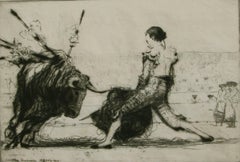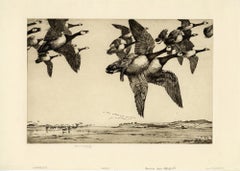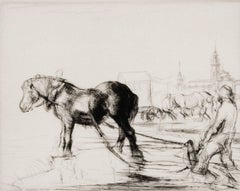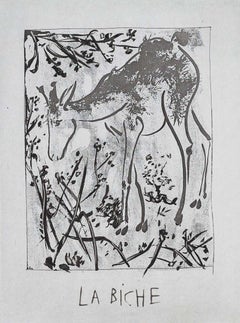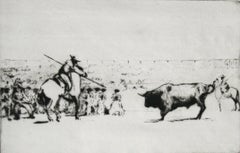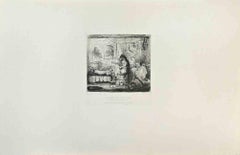Drypoint Animal Prints
to
9
10
9
15
Overall Width
to
Overall Height
to
35
12
7
2
2
2
2
13
9
3
2
1
2
33
3
6
2
1
3
18
16
20
16
13
5
4
4
4
3
3
2
2
2
2
2
2
1
1
1
1
1
1,348
784
734
353
275
13
1
32
3
Style: Modern
Medium: Drypoint
A Fierce Bull
By James McBey
Located in Storrs, CT
A Fierce Bull. 1911. Drypoint. Hardie 108. 5 3/8 x 8 (sheet 8 5/16 x 11 7/8). Edition 8. An exceptional impression with rich drypoint burr printed on antique laid paper. A proof of t...
Category
1910s Modern Drypoint Animal Prints
Materials
Drypoint, Etching
$1,500 Sale Price
40% Off
Barnacle Geese Affrighted
Located in Middletown, NY
Etching and drypoint on cream wove paper, full margins. Signed and numbered 59/75 in pencil, lower margin. Notations in pencil along the lower sheet edge, recto, well outside of ima...
Category
Mid-20th Century Modern Drypoint Animal Prints
Materials
Handmade Paper, Drypoint, Etching
Ostend Horse
Located in Storrs, CT
Ostend Horse. 1926-27. Drypoint. Appleby 125. 7 x 815/16 (sheet 9 1/8x 12 1/5). Proof B, apart from the edition 100. A rich impression with tonal wiping and drypoint burr, printed on...
Category
1920s Modern Drypoint Animal Prints
Materials
Drypoint, Etching
The Deer, 1942 (Histoire Naturelle - Textes de Buffon, B.336)
Located in Greenwich, CT
The Deer is an aquatint and drypoint print on chine from one of the deluxe copies of Picasso's 1942 Histoire Naturelle - Textes de Buffon series. The image size is 10.5 x 8.15 inches, unsigned as issued, and framed in a contemporary silver and gray moulding. One of about 36 prints that exist with Picasso's remarqued title in French, from the edition of 262 (there were 226 portfolios, some with additional sets on varying papers).
Catalogue - Cramer #37
The exceptional etchings from Picasso’s Histoire Naturelle – Textes de Buffon are a masterful combination of sugar-lift aquatint and drypoint, showcasing a full range of gray tonalities. The etchings of animals, birds and insects are considered some of the most beautiful and most unusual examples of Picasso’s graphic work.
Roger Lacourière, Picasso’s master printer, pulled the prints for each etching between 1939-1942. It was Lacourière who taught Picasso the sugar-lift aquatint technique which allowed him to mimic the effect of brushstrokes in these etched images. Picasso first explored the technique in his plates for the Vollard Suite, but it was in the creation of the Buffon images that he fully realized its stunning, painterly potential.
For the edition, 226 portfolios were produced with the first thirty-six counting as deluxe compilations. These rare deluxe sets were on diverse papers (chine, japon or vergé ancien) and each included a complete additional suite showing Picasso’s title remarques along the bottom. As such, the remarqued versions of the prints are quite rare with just thirty-six of each produced for the edition (with the exception of The Wolf which is never remarqued – the image always fills the entire etching plate).
These prints are based on the writings of French naturalist Georges-Louis Leclerc, Comte de Buffon, who extensively documented the natural world in his monumental work Histoire Naturelle. Picasso’s association with the project to illustrate parts of the Buffon came during a tumultuous time in European history – the prelude to, and early years of, World War II. As the continent was ravaged, Picasso lived through the disaster in Paris, which the Germans occupied in 1940. These prints could be seen as a political statement – Picasso channeling his artistic expression into a form of resistance art...
Category
20th Century Modern Drypoint Animal Prints
Materials
Drypoint, Aquatint
The Picador Incites the Bull.
By James McBey
Located in Storrs, CT
The Picador Incites the Bull. 1911. Drypoint. Hardie 104. 6 1/4 x 9 7/8 (sheet 8 1/4 x 11 7/8). Edition 30, #5. Slight mat line, 1 hinge stain in the lower margin, well outside the i...
Category
1910s Modern Drypoint Animal Prints
Materials
Drypoint
$1,200 Sale Price
27% Off
La Mort du Chat Murr - Etching by Jean François Raffaëlli - 1875
Located in Roma, IT
Etching on laid paper
Signed in plate lower left: Jean François Raffaëlli.
Published by Cadart & Luquet, Éditeurs, 79 Rue Richelieu, Paris
With the blindstamp of the Société des Aqua...
Category
1870s Modern Drypoint Animal Prints
Materials
Drypoint, Etching
Bernard Sanders, Dancers
Located in New York, NY
Sander's interiors are always intriguing. This work also reads as a stage with a dance; it recalls the Porch of the Maidens at the Erectheum at the Acropolis in Athens. There of cour...
Category
Early 20th Century American Modern Drypoint Animal Prints
Materials
Drypoint
The Cat - Etching and Drypoint by Giselle Halff- 1950s
Located in Roma, IT
The Cat is an Original etching and drypoint print on paper realized by an Anonymous artist in 1950 ca.
Good conditions with some foxing.
Category
1950s Modern Drypoint Animal Prints
Materials
Etching, Drypoint
"Le Bouclier, " Original Drypoint Etching signed by Claude Weisbuch
Located in Milwaukee, WI
"Le Bouclier" is an original drypoint etching by Claude Weisbuch. The artist signed the piece lower right and wrote the edition number (25/100) in the lower left. This piece depicts ...
Category
1970s Modern Drypoint Animal Prints
Materials
Drypoint, Etching
The Pigeon, 1942 (Histoire Naturelle - Textes de Buffon, B.347)
Located in Greenwich, CT
The Pigeon is an aquatint and drypoint print on chine from one of the deluxe copies of Picasso's 1942 Histoire Naturelle - Textes de Buffon series. The image size is 10.75x 8 inches, unsigned as issued, and framed in a contemporary silver and gray moulding. One of about 36 prints that exist with Picasso's remarqued title in French, from the edition of 262 (there were 226 portfolios, some with additional sets on varying papers).
Catalogue - Cramer #37
The exceptional etchings from Picasso’s Histoire Naturelle – Textes de Buffon are a masterful combination of sugar-lift aquatint and drypoint, showcasing a full range of gray tonalities. The etchings of animals, birds and insects are considered some of the most beautiful and most unusual examples of Picasso’s graphic work.
Roger Lacourière, Picasso’s master printer, pulled the prints for each etching between 1939-1942. It was Lacourière who taught Picasso the sugar-lift aquatint technique which allowed him to mimic the effect of brushstrokes in these etched images. Picasso first explored the technique in his plates for the Vollard Suite, but it was in the creation of the Buffon images that he fully realized its stunning, painterly potential.
For the edition, 226 portfolios were produced with the first thirty-six counting as deluxe compilations. These rare deluxe sets were on diverse papers (chine, japon or vergé ancien) and each included a complete additional suite showing Picasso’s title remarques along the bottom. As such, the remarqued versions of the prints are quite rare with just thirty-six of each produced for the edition (with the exception of The Wolf which is never remarqued – the image always fills the entire etching plate).
These prints are based on the writings of French naturalist Georges-Louis Leclerc, Comte de Buffon, who extensively documented the natural world in his monumental work Histoire Naturelle. Picasso’s association with the project to illustrate parts of the Buffon came during a tumultuous time in European history – the prelude to, and early years of, World War II. As the continent was ravaged, Picasso lived through the disaster in Paris, which the Germans occupied in 1940. These prints could be seen as a political statement – Picasso channeling his artistic expression into a form of resistance art...
Category
20th Century Modern Drypoint Animal Prints
Materials
Drypoint, Aquatint
The Sparrow Hawk, 1942 (Histoire Naturelle - Textes de Buffon, B.342)
Located in Greenwich, CT
The Sparrow Hawk is an aquatint and drypoint print on chine from one of the deluxe copies of Picasso's 1942 Histoire Naturelle - Textes de Buffon series. The image size is 10.5 x 8 inches, unsigned as issued, and framed in a contemporary silver and gray moulding. One of about 36 prints that exist with Picasso's remarqued title in French, from the edition of 262 (there were 226 portfolios, some with additional sets on varying papers).
Catalogue - Cramer #37
The exceptional etchings from Picasso’s Histoire Naturelle – Textes de Buffon are a masterful combination of sugar-lift aquatint and drypoint, showcasing a full range of gray tonalities. The etchings of animals, birds and insects are considered some of the most beautiful and most unusual examples of Picasso’s graphic work.
Roger Lacourière, Picasso’s master printer, pulled the prints for each etching between 1939-1942. It was Lacourière who taught Picasso the sugar-lift aquatint technique which allowed him to mimic the effect of brushstrokes in these etched images. Picasso first explored the technique in his plates for the Vollard Suite, but it was in the creation of the Buffon images that he fully realized its stunning, painterly potential.
For the edition, 226 portfolios were produced with the first thirty-six counting as deluxe compilations. These rare deluxe sets were on diverse papers (chine, japon or vergé ancien) and each included a complete additional suite showing Picasso’s title remarques along the bottom. As such, the remarqued versions of the prints are quite rare with just thirty-six of each produced for the edition (with the exception of The Wolf which is never remarqued – the image always fills the entire etching plate).
These prints are based on the writings of French naturalist Georges-Louis Leclerc, Comte de Buffon, who extensively documented the natural world in his monumental work Histoire Naturelle. Picasso’s association with the project to illustrate parts of the Buffon came during a tumultuous time in European history – the prelude to, and early years of, World War II. As the continent was ravaged, Picasso lived through the disaster in Paris, which the Germans occupied in 1940. These prints could be seen as a political statement – Picasso channeling his artistic expression into a form of resistance art...
Category
20th Century Modern Drypoint Animal Prints
Materials
Drypoint, Aquatint
The Monkey, 1942 (Histoire Naturelle - Textes de Buffon, B.339)
Located in Greenwich, CT
The Monkey is an aquatint and drypoint print on chine from one of the deluxe copies of Picasso's 1942 Histoire Naturelle - Textes de Buffon series. The image size is 10.5 x 7.9 inche...
Category
20th Century Modern Drypoint Animal Prints
Materials
Drypoint, Aquatint
The Mother Hen, 1942 (Histoire Naturelle - Textes de Buffon, B.345)
Located in Greenwich, CT
The Mother Hen is an aquatint and drypoint print on chine from one of the deluxe copies of Picasso's 1942 Histoire Naturelle - Textes de Buffon series. The image size is 10.6 x 8 inc...
Category
20th Century Modern Drypoint Animal Prints
Materials
Drypoint, Aquatint
The Goldfinch, 1942 (Histoire Naturelle - Textes de Buffon, B.348 )
Located in Greenwich, CT
The Goldfinch is an aquatint and drypoint print on chine from one of the deluxe copies of Picasso's 1942 Histoire Naturelle - Textes de Buffon series. The image size is 11.2 x 8.25 inches, unsigned as issued, and framed in a contemporary silver and gray moulding. One of about 36 prints that exist with Picasso's remarqued title in French, from the edition of 262 (there were 226 portfolios, some with additional sets on varying papers).
Catalogue - Cramer #37
The exceptional etchings from Picasso’s Histoire Naturelle – Textes de Buffon are a masterful combination of sugar-lift aquatint and drypoint, showcasing a full range of gray tonalities. The etchings of animals, birds and insects are considered some of the most beautiful and most unusual examples of Picasso’s graphic work.
Roger Lacourière, Picasso’s master printer, pulled the prints for each etching between 1939-1942. It was Lacourière who taught Picasso the sugar-lift aquatint technique which allowed him to mimic the effect of brushstrokes in these etched images. Picasso first explored the technique in his plates for the Vollard Suite, but it was in the creation of the Buffon images that he fully realized its stunning, painterly potential.
For the edition, 226 portfolios were produced with the first thirty-six counting as deluxe compilations. These rare deluxe sets were on diverse papers (chine, japon or vergé ancien) and each included a complete additional suite showing Picasso’s title remarques along the bottom. As such, the remarqued versions of the prints are quite rare with just thirty-six of each produced for the edition (with the exception of The Wolf which is never remarqued – the image always fills the entire etching plate).
These prints are based on the writings of French naturalist Georges-Louis Leclerc, Comte de Buffon, who extensively documented the natural world in his monumental work Histoire Naturelle. Picasso’s association with the project to illustrate parts of the Buffon came during a tumultuous time in European history – the prelude to, and early years of, World War II. As the continent was ravaged, Picasso lived through the disaster in Paris, which the Germans occupied in 1940. These prints could be seen as a political statement – Picasso channeling his artistic expression into a form of resistance art...
Category
20th Century Modern Drypoint Animal Prints
Materials
Drypoint, Aquatint
The Lobster, 1942 (Histoire Naturelle - Textes de Buffon, B.352)
Located in Greenwich, CT
The Lobster is an aquatint and drypoint print on chine from one of the deluxe copies of Picasso's 1942 Histoire Naturelle - Textes de Buffon series. The image size is 10.6 x 7.9 inches, unsigned as issued, and framed in a contemporary silver and gray moulding. One of about 36 prints that exist with Picasso's remarqued title in French, from the edition of 262 (there were 226 portfolios, some with additional sets on varying papers).
Catalogue - Cramer #37
The exceptional etchings from Picasso’s Histoire Naturelle – Textes de Buffon are a masterful combination of sugar-lift aquatint and drypoint, showcasing a full range of gray tonalities. The etchings of animals, birds and insects are considered some of the most beautiful and most unusual examples of Picasso’s graphic work.
Roger Lacourière, Picasso’s master printer, pulled the prints for each etching between 1939-1942. It was Lacourière who taught Picasso the sugar-lift aquatint technique which allowed him to mimic the effect of brushstrokes in these etched images. Picasso first explored the technique in his plates for the Vollard Suite, but it was in the creation of the Buffon images that he fully realized its stunning, painterly potential.
For the edition, 226 portfolios were produced with the first thirty-six counting as deluxe compilations. These rare deluxe sets were on diverse papers (chine, japon or vergé ancien) and each included a complete additional suite showing Picasso’s title remarques along the bottom. As such, the remarqued versions of the prints are quite rare with just thirty-six of each produced for the edition (with the exception of The Wolf which is never remarqued – the image always fills the entire etching plate).
These prints are based on the writings of French naturalist Georges-Louis Leclerc, Comte de Buffon, who extensively documented the natural world in his monumental work Histoire Naturelle. Picasso’s association with the project to illustrate parts of the Buffon came during a tumultuous time in European history – the prelude to, and early years of, World War II. As the continent was ravaged, Picasso lived through the disaster in Paris, which the Germans occupied in 1940. These prints could be seen as a political statement – Picasso channeling his artistic expression into a form of resistance art...
Category
20th Century Modern Drypoint Animal Prints
Materials
Drypoint, Aquatint
The White Eagle, 1942 (Histoire Naturelle - Textes de Buffon, B.340)
Located in Greenwich, CT
The White Eagle is an aquatint and drypoint print on chine from one of the deluxe copies of Picasso's 1942 Histoire Naturelle - Textes de Buffon series. The image size is 10.5 x 8.15 inches, unsigned as issued, and framed in a contemporary silver and gray moulding. One of about 36 prints that exist with Picasso's remarqued title in French, from the edition of 262 (there were 226 portfolios, some with additional sets on varying papers).
Catalogue - Cramer #37
The exceptional etchings from Picasso’s Histoire Naturelle – Textes de Buffon are a masterful combination of sugar-lift aquatint and drypoint, showcasing a full range of gray tonalities. The etchings of animals, birds and insects are considered some of the most beautiful and most unusual examples of Picasso’s graphic work.
Roger Lacourière, Picasso’s master printer, pulled the prints for each etching between 1939-1942. It was Lacourière who taught Picasso the sugar-lift aquatint technique which allowed him to mimic the effect of brushstrokes in these etched images. Picasso first explored the technique in his plates for the Vollard Suite, but it was in the creation of the Buffon images that he fully realized its stunning, painterly potential.
For the edition, 226 portfolios were produced with the first thirty-six counting as deluxe compilations. These rare deluxe sets were on diverse papers (chine, japon or vergé ancien) and each included a complete additional suite showing Picasso’s title remarques along the bottom. As such, the remarqued versions of the prints are quite rare with just thirty-six of each produced for the edition (with the exception of The Wolf which is never remarqued – the image always fills the entire etching plate).
These prints are based on the writings of French naturalist Georges-Louis Leclerc, Comte de Buffon, who extensively documented the natural world in his monumental work Histoire Naturelle. Picasso’s association with the project to illustrate parts of the Buffon came during a tumultuous time in European history – the prelude to, and early years of, World War II. As the continent was ravaged, Picasso lived through the disaster in Paris, which the Germans occupied in 1940. These prints could be seen as a political statement – Picasso channeling his artistic expression into a form of resistance art...
Category
20th Century Modern Drypoint Animal Prints
Materials
Drypoint, Aquatint
Returning to the Stable.
Located in Storrs, CT
Returning to the Stable. 1920. Drypoint. Appleby 64. 8 3/4 x 12 1/4 (sheet 11 7/16 x 16 1/8). Edition 100. A rich impression printed on cream laid paper wi...
Category
1920s Modern Drypoint Animal Prints
Materials
Drypoint, Etching
$800 Sale Price
36% Off
Night Time, Dieppe.
Located in Storrs, CT
Night Time, Dieppe. 1926-27. Drypoint. Appleby 123. 7 7/8 x 11/ Edition 100. A fine impression printed on cream laid paper with full margins. Signed in penc...
Category
1920s Modern Drypoint Animal Prints
Materials
Drypoint, Etching
$975 Sale Price
22% Off
The Butterfly.
Located in Storrs, CT
Edmund Blampied, R.E. The Butterfly. 1928-29. Drypoint. Appleby 133. 9 5/8 x 7 7/8). Etching (sheet 15 1/4 x 10 3/16)on 100. A rich impression printed on cream-colored laid 'F.J.He...
Category
Early 20th Century Modern Drypoint Animal Prints
Materials
Drypoint, Etching
$1,200 Sale Price
40% Off
The Matador.
By James McBey
Located in Storrs, CT
The Matador. 1911. Drypoint. Hardie 109. 6 7/8 x 10 7/8 (sheet 7 7/8 x 12). Edition 15. A few scattered foxing marks and slight mat line; otherwise fine o...
Category
1910s Modern Drypoint Animal Prints
Materials
Drypoint, Etching
$1,200 Sale Price
27% Off
Night Time in a Stable.
Located in Storrs, CT
Night Time in a Stable. 1927-28. Drypoint. Appleby 131. 10 1/8 x 12 1/8 (sheet 11 1/2 x 16 1/2). Edition 100. Illustrated: Print Collector's Quarterly 25 (1...
Category
Early 20th Century Modern Drypoint Animal Prints
Materials
Drypoint, Etching
Misty Morning.
Located in Storrs, CT
Misty Morning. 1928-29. Drypoint. Appleby 137. 8 5/8 x 12 (sheet 11 5/8 x 18 1/16). Edition 100, #86. A rich impression with drypoint burr. Printed with ...
Category
1920s Modern Drypoint Animal Prints
Materials
Drypoint, Etching
Lumbermen.
Located in Storrs, CT
Lumbermen. 1923. Etching. Appleby 91. 9 x 12 (sheet 12 3/8 x 18 1/8). Edition 100. A cleanly-wiped impression printed on off-white 'FG Head & Co' laid paper with full margins. Signed...
Category
1920s Modern Drypoint Animal Prints
Materials
Drypoint, Etching
$500 Sale Price
33% Off
The Vraic Season (No 1).
Located in Storrs, CT
The Vraic Season (No 1). 1936. Etching. Appleby 181. 12 x 14 1/4 (sheet 15 1/4 x 20). Edition 125 for The American College Society of Print Collectors (alternatively titled Seaweed H...
Category
1930s Modern Drypoint Animal Prints
Materials
Drypoint, Etching
$900 Sale Price
40% Off
Through the Storm.
Located in Storrs, CT
Appleby 97. 4 x 6 15/16 (sheet 8 1/8 x 10 3/8). Edition 100. A rich impression with drypoint burr and carefully wiped plate tone, printed on 'FJ Head' paper, on the full sheet with ...
Category
1920s Modern Drypoint Animal Prints
Materials
Drypoint, Etching
Cowdray Castle (with Geese)
Located in Roma, IT
Beautiful proof on vergé crème, signed by the artist in pencil.
Full margins. Ex-coll. H.H. Benedict (Lugt 1298).
Ref. Cat. Harrington 221; Schneiderman 208.
Category
1880s Modern Drypoint Animal Prints
Materials
Drypoint, Etching
A. Schultz, Riders in Central Park (New York City)
Located in New York, NY
Such an innovative image on the classic 'Riders in the Park' theme! Further, the use of drypoint and the rather direct -- even aggressive -- drawing style, bring it into the German E...
Category
1930s American Modern Drypoint Animal Prints
Materials
Drypoint
"The Winner" - Etching on Paper (10/25)
Located in Soquel, CA
"The Winner" - Etching on Paper
Clean and modern drypoint etching of a horse skeleton by Maria Bennett (American, 20th Century). This etching has layer...
Category
1970s Modern Drypoint Animal Prints
Materials
Paper, Ink, Drypoint
$460 Sale Price
20% Off
20th century drypoint etching figurative animal print horses sketch signed
Located in Milwaukee, WI
"Combat Equestre" is an original lithograph by Claude Weisbuch. The artist signed the piece lower right and wrote the edition number (24/100) in the lower left. This piece depicts mu...
Category
1970s Modern Drypoint Animal Prints
Materials
Drypoint, Etching
The Wasp, 1942 (Histoire Naturelle - Textes de Buffon, B.351)
Located in Greenwich, CT
The Wasp is an aquatint and drypoint print on chine from one of the deluxe copies of Picasso's 1942 Histoire Naturelle - Textes de Buffon series. The image size is 10.6 x 8 inches, u...
Category
20th Century Modern Drypoint Animal Prints
Materials
Drypoint, Aquatint
The Donkey, 1942 (Histoire Naturelle - Textes de Buffon, B.329)
Located in Greenwich, CT
The Donkey is an aquatint and drypoint print on chine from one of the deluxe copies of Picasso's 1942 Histoire Naturelle - Textes de Buffon series. The image size is 10.5 x 8 inches,...
Category
20th Century Modern Drypoint Animal Prints
Materials
Drypoint, Aquatint
Bernard Sanders, Bird on Piano
Located in New York, NY
Sander's interiors are always intriguing. This one certainly is. Signed in pencil.
Category
Early 20th Century American Modern Drypoint Animal Prints
Materials
Drypoint
The Spider, 1942 (Histoire Naturelle - Textes de Buffon, B.353)
Located in Greenwich, CT
The Spider is an aquatint and drypoint print on chine from one of the deluxe copies of Picasso's 1942 Histoire Naturelle - Textes de Buffon series. The image size is 10.5 x 8 inches, unsigned as issued, and framed in a contemporary silver and gray moulding. One of about 36 prints that exist with Picasso's remarqued title in French, from the edition of 262 (there were 226 portfolios, some with additional sets on varying papers).
Catalogue - Cramer #37
The exceptional etchings from Picasso’s Histoire Naturelle – Textes de Buffon are a masterful combination of sugar-lift aquatint and drypoint, showcasing a full range of gray tonalities. The etchings of animals, birds and insects are considered some of the most beautiful and most unusual examples of Picasso’s graphic work.
Roger Lacourière, Picasso’s master printer, pulled the prints for each etching between 1939-1942. It was Lacourière who taught Picasso the sugar-lift aquatint technique which allowed him to mimic the effect of brushstrokes in these etched images. Picasso first explored the technique in his plates for the Vollard Suite, but it was in the creation of the Buffon images that he fully realized its stunning, painterly potential.
For the edition, 226 portfolios were produced with the first thirty-six counting as deluxe compilations. These rare deluxe sets were on diverse papers (chine, japon or vergé ancien) and each included a complete additional suite showing Picasso’s title remarques along the bottom. As such, the remarqued versions of the prints are quite rare with just thirty-six of each produced for the edition (with the exception of The Wolf which is never remarqued – the image always fills the entire etching plate).
These prints are based on the writings of French naturalist Georges-Louis Leclerc, Comte de Buffon, who extensively documented the natural world in his monumental work Histoire Naturelle. Picasso’s association with the project to illustrate parts of the Buffon came during a tumultuous time in European history – the prelude to, and early years of, World War II. As the continent was ravaged, Picasso lived through the disaster in Paris, which the Germans occupied in 1940. These prints could be seen as a political statement – Picasso channeling his artistic expression into a form of resistance art...
Category
20th Century Modern Drypoint Animal Prints
Materials
Drypoint, Aquatint
The Vulture. 1942 (Histoire Naturelle - Textes de Buffon, B.341)
Located in Greenwich, CT
The Vulture is an aquatint and drypoint print on chine from one of the deluxe copies of Picasso's 1942 Histoire Naturelle - Textes de Buffon series. The image size is 10.6 x 8 inches, unsigned as issued, and framed in a contemporary silver and gray moulding. One of about 36 prints that exist with Picasso's remarqued title in French, from the edition of 262 (there were 226 portfolios, some with additional sets on varying papers).
Catalogue - Cramer #37
The exceptional etchings from Picasso’s Histoire Naturelle – Textes de Buffon are a masterful combination of sugar-lift aquatint and drypoint, showcasing a full range of gray tonalities. The etchings of animals, birds and insects are considered some of the most beautiful and most unusual examples of Picasso’s graphic work.
Roger Lacourière, Picasso’s master printer, pulled the prints for each etching between 1939-1942. It was Lacourière who taught Picasso the sugar-lift aquatint technique which allowed him to mimic the effect of brushstrokes in these etched images. Picasso first explored the technique in his plates for the Vollard Suite, but it was in the creation of the Buffon images that he fully realized its stunning, painterly potential.
For the edition, 226 portfolios were produced with the first thirty-six counting as deluxe compilations. These rare deluxe sets were on diverse papers (chine, japon or vergé ancien) and each included a complete additional suite showing Picasso’s title remarques along the bottom. As such, the remarqued versions of the prints are quite rare with just thirty-six of each produced for the edition (with the exception of The Wolf which is never remarqued – the image always fills the entire etching plate).
These prints are based on the writings of French naturalist Georges-Louis Leclerc, Comte de Buffon, who extensively documented the natural world in his monumental work Histoire Naturelle. Picasso’s association with the project to illustrate parts of the Buffon came during a tumultuous time in European history – the prelude to, and early years of, World War II. As the continent was ravaged, Picasso lived through the disaster in Paris, which the Germans occupied in 1940. These prints could be seen as a political statement – Picasso channeling his artistic expression into a form of resistance art...
Category
20th Century Modern Drypoint Animal Prints
Materials
Drypoint, Aquatint
The Rooster, 1942 (Histoire Naturelle - Textes de Buffon, B.344)
Located in Greenwich, CT
The Rooster is an aquatint and drypoint print on chine from one of the deluxe copies of Picasso's 1942 Histoire Naturelle - Textes de Buffon series. The image size is 10.6 x 8.15 inc...
Category
20th Century Modern Drypoint Animal Prints
Materials
Drypoint, Aquatint
Drypoint animal prints for sale on 1stDibs.
Find a wide variety of authentic Drypoint animal prints available on 1stDibs. While artists have worked in this medium across a range of time periods, art made with this material during the 21st Century is especially popular. If you’re looking to add animal prints created with this material to introduce a provocative pop of color and texture to an otherwise neutral space in your home, the works available on 1stDibs include elements of yellow and other colors. There are many well-known artists whose body of work includes ceramic sculptures. Popular artists on 1stDibs associated with pieces like this include Salvador Dalí, Pablo Picasso, Edmund Blampied, and James McBey.. Frequently made by artists working in the Modern, Surrealist, all of these pieces for sale are unique and many will draw the attention of guests in your home. Not every interior allows for large Drypoint animal prints, so small editions measuring 0.5 inches across are also available
Recently Viewed
View AllMore Ways To Browse
Le Singe Et Le Leopard
Leon Danchin On Sale
Louis Prang Chromolithograph
Man O War Horse
Manetti Saverio
Natural History Museum Vintage Prints
Penguin Lithograph
Peter Klucik
Pheasant Engraving
Picasso Dove Of Peace
Picasso Le Taureau
Picasso Rooster
Ronald Smith
Rooster Print Picasso
Salvador Dali Argus
Salvador Dali Unicorn
Sam Savitt
Shore Bird Print
